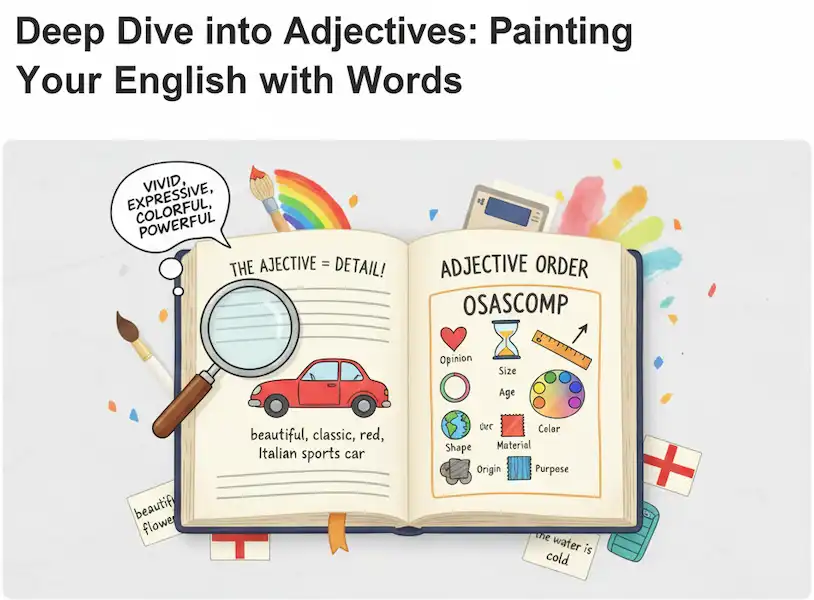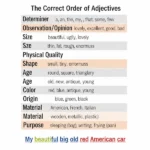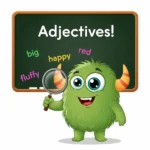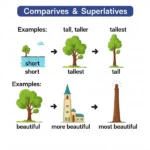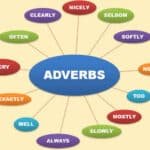Deep Dive into Adjectives: Painting Your English with Words
Welcome, intermediate English students! Today, we’re going on an exciting journey into the world of adjectives – those powerful little words that add color, detail, and precision to your sentences. Understanding and using adjectives effectively will not only make your writing more vivid but also improve your comprehension of complex texts. Learn about English adjective types. Let’s dive in!
What is an Adjective?
At its core, an adjective is a word that describes or modifies a noun or a pronoun. It tells us more about the noun’s qualities, characteristics, or state. Think of them as the artists of language, adding strokes of detail to the blank canvas of your sentences.
Example:
- The red car. (describes the color of the car)
- A tall building. (describes the height of the building)
- She is happy. (describes her emotional state)
Why are Adjectives Important for Intermediate Learners?
As you progress in your English studies, simply conveying basic meaning isn’t enough. You want to express nuances, evoke emotions, and paint a clearer picture for your reader or listener. Adjectives are your secret weapon for:
- Clarity: Distinguishing between similar nouns (e.g., “a small dog” vs. “a large dog”).
- Vividness: Making your descriptions more engaging and interesting (e.g., “a boring story” vs. “a captivating story”).
- Precision: Communicating exact details (e.g., “a good meal” vs. “a delicious, spicy meal”).
- Expressing Opinion/Emotion: Conveying your feelings about something (e.g., “a terrible movie” vs. “an inspiring movie”).
English Adjective Types: More Than Just “Big” and “Small”
Adjectives come in various forms, each serving a specific purpose. Understanding these types will greatly expand your descriptive abilities.
1. Descriptive Adjectives
These are the most common type, describing a quality or characteristic of a noun.
Examples:
- Color: blue, green, scarlet
- Size: tiny, enormous, microscopic
- Shape: round, square, triangular
- Taste: sweet, bitter, sour
- Sound: loud, quiet, melodic
- Texture: smooth, rough, silky
- Feelings: happy, sad, angry
- Qualities: intelligent, brave, clumsy
Sentence Examples:
- The fluffy cat slept peacefully.
- He told a hilarious joke.
- We admired the ancient ruins.
2. Demonstrative Adjectives
These point out specific nouns: this, that, these, those. They always come before the noun they modify.
Examples:
- This book is mine. (singular, near)
- That house is old. (singular, far)
- These shoes are new. (plural, near)
- Those birds are singing. (plural, far)
3. Possessive Adjectives
These show ownership or possession: my, your, his, her, its, our, their. Like demonstrative adjectives, they always precede the noun.
Examples:
- My car is parked outside.
- Is your phone charged?
- Their dog is very friendly.
4. Quantitative Adjectives
These specify the quantity or amount of a noun.
Examples:
- Some students are absent.
- She ate few cookies.
- I need much more time.
- He has no money.
- All the children played.
5. Interrogative Adjectives
These are used in questions and precede the noun: which, what, whose.
Examples:
- Which movie do you want to watch?
- What color is your car?
- Whose pen is this?
6. Distributive Adjectives
These refer to individual members within a group: each, every, either, neither.
Examples:
- Each student received a prize.
- Every day is a new opportunity.
- You can take either path.
7. Proper Adjectives
These are formed from proper nouns (names of specific people, places, or things) and are always capitalized.
Examples:
- American history (from America)
- Shakespearean plays (from Shakespeare)
- French cuisine (from France)
- Victorian era (from Queen Victoria)
8. Compound Adjectives
These are formed by combining two or more words, often hyphenated, to act as a single adjective.
Examples:
- a well-known author
- a long-term plan
- a ten-year-old boy
- a state-of-the-art computer
Adjective Placement: Where Do They Go?
Understanding where to place English adjective types is crucial for grammatical correctness and clear communication.
1. Attributive Position (Before the Noun)
This is the most common position. The adjective comes directly before the noun it modifies.
Structure: Adjective + Noun
Examples:
- The curious cat.
- A difficult problem.
- Beautiful flowers
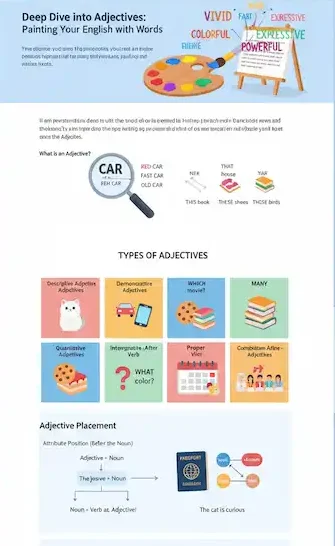
2. Predicative Position (After a Linking Verb)
When an adjective follows a linking verb (like be, seem, appear, feel, taste, smell, sound, look, become, get), it describes the subject of the sentence.
Structure: Noun/Pronoun + Linking Verb + Adjective
Examples:
- The cat is curious.
- The problem seemed difficult.
- The flowers smell beautiful.
- She became angry.
- He feels sad.
3. After the Noun (Less Common, for Specific Cases)
Sometimes adjectives appear immediately after the noun, especially in certain formal or literary contexts, or when there are multiple adjectives or a phrase.
Examples:
- The president elect (meaning ‘the elected president’).
- The general, exhausted and wounded, surrendered.
- Someone special (this is an exception where the adjective always follows).
- Something wonderful.
Order of Adjectives: The “Royal Order”
When you use multiple descriptive adjectives before a noun, there’s a conventional order that native speakers naturally follow. While not strict grammatical rules, following this order makes your sentences sound more natural.
Here’s a common order, often remembered by the acronym OSASCOMP:
- Opinion: beautiful, ugly, lovely, delicious
- Size: big, small, tiny, enormous
- Age: old, new, ancient, young
- Shape: round, square, triangular, oval
- Color: red, blue, green, golden
- Origin: American, French, wooden, plastic
- Material: wooden, metallic, cotton, silk
- Purpose: sleeping (bag), writing (desk), frying (pan)
Chart: Order of Adjectives
| Order | Category | Examples |
| 1st | Opinion | lovely, horrible, charming |
| 2nd | Size | tiny, huge, short |
| 3rd | Age | ancient, modern, brand-new |
| 4th | Shape | round, square, wavy |
| 5th | Color | red, black, vibrant green |
| 6th | Origin | Italian, Asian, Martian |
| 7th | Material | wooden, silk, glass |
| 8th | Purpose | sleeping (bag), dining (table) |
Examples:
- A beautiful, small, old, round, red, Italian, wooden box.
- The horrible, huge, new, rectangular, black, plastic trash can.
Note: It’s rare to use more than three or four adjectives before a single noun, as it can sound clunky.
Degrees of Adjectives: Comparing Things
Adjectives have three “degrees” to show comparison: positive, comparative, and superlative.
1. Positive Adjective Degree
This is the base form of the adjective, describing a single noun without comparison.
Examples:
- She is tall.
- This book is interesting.
- The cake is good.
2. Comparative Adjective Degree
Used to compare two nouns or pronouns.
- For short adjectives (1-2 syllables): Add “-er” to the end.
- tall → taller
- small → smaller
- happy → happier (y changes to i)
- For longer adjectives (2+ syllables): Use “more” before the adjective.
- interesting → more interesting
- beautiful → more beautiful
Sentence Examples:
- She is taller than her brother.
- This book is more interesting than the last one.
3. Superlative Adjective Degree
Used to compare three or more nouns or pronouns, indicating the highest or lowest degree of a quality.
- For short adjectives: Add “the” and “-est” to the end.
- tall → the tallest
- small → the smallest
- happy → the happiest
- For longer adjectives: Use “the most” before the adjective.
- interesting → the most interesting
- beautiful → the most beautiful
Sentence Examples:
- She is the tallest student in the class.
- This is the most interesting book I’ve ever read.
Irregular Adjectives
Some adjectives have irregular comparative and superlative forms that you need to memorize.
| Positive | Comparative | Superlative |
| good | better | best |
| bad | worse | worst |
| far | farther/further | farthest/furthest |
| much/many | more | most |
| little | less | least |
Example:
- This is a good idea.
- That’s a better idea.
- That’s the best idea.
Common Mistakes with Adjectives
Even advanced learners sometimes make these mistakes. Being aware of them will help you refine your English.
1. Misusing Adjectives and Adverbs
Remember, adjectives modify nouns/pronouns, while adverbs modify verbs, adjectives, or other adverbs.
- Incorrect: He drives quick. (Quick is an adjective)
- Correct: He drives quickly. (Quickly is an adverb, modifying the verb “drives”)
- Correct: He has a quick car. (Quick is an adjective, modifying the noun “car”)
2. Double Comparatives/Superlatives
Avoid using both “-er” and “more” or “-est” and “most” together.
- Incorrect: This is more easier.
- Correct: This is easier.
- Incorrect: She is the most happiest.
- Correct: She is the happiest.
3. Using Adjectives that Can’t be Graded (Absolute Adjectives)
Some adjectives describe qualities that are either true or not true; they can’t be “more” or “most.”
Examples:
- Unique: Something is either unique or not. It can’t be “more unique.” (You can say “almost unique” or “truly unique.”)
- Dead: Someone is either dead or not. They can’t be “more dead.”
- Perfect, complete, essential, empty, full, pregnant.
Incorrect: The circle is more round.Correct: The circle is perfectly round.
Beyond the Basics: Adjectives and Style
Using a variety of strong adjectives can significantly enhance your writing style. However, remember that sometimes, fewer well-chosen adjectives are more effective than many weak ones. Don’t just add adjectives for the sake of it; ensure each one contributes to the meaning and imagery.
Example:
- Weak: The nice, good, interesting story.
- Strong: The compelling, insightful, poignant narrative.
Choosing the right adjective can transform a bland sentence into a vivid picture in the reader’s mind.
Practice Makes Perfect
The best way to master adjectives is to use them!
- Describe Everything: Look around you and mentally describe objects using as many adjectives as you can.
- Instead of “a tree,” think “a tall, ancient, leafy, green tree.”
- Rewrite Sentences: Take simple sentences and add adjectives to make them more interesting.
- Original: The cat ran.
- Improved: The small, black cat ran swiftly (adverb, but shows contrast!). The playful cat ran quickly after the red ball.
- Read Actively: Pay attention to how authors use adjectives in books, articles, and stories. What effect do they create?
Here is a PDF worksheet you can download to practice English adjective types and placement, The answers are on a separate page.
Conclusion
Adjectives are indispensable tools for any English speaker looking to move beyond basic communication. By understanding their types, placement, degrees, and common pitfalls, you can unlock a new level of descriptive power in your writing and speaking. Keep practicing, keep observing, and enjoy painting your English with an ever-richer palette of words!
Additional Helpful Links
- Study adjectives for beginner English students – Learning About Adjectives: English for Beginner Students
External Links for Further Learning
- The Purdue OWL – Adjectives (A highly respected resource for English grammar)
- Grammarly Blog – Adjectives (Clear explanations and examples)
- Cambridge Dictionary – Adjective Definition and Examples (Includes useful information on adjective usage)
- British Council LearnEnglish – Adjectives (Exercises and explanations for learners)
